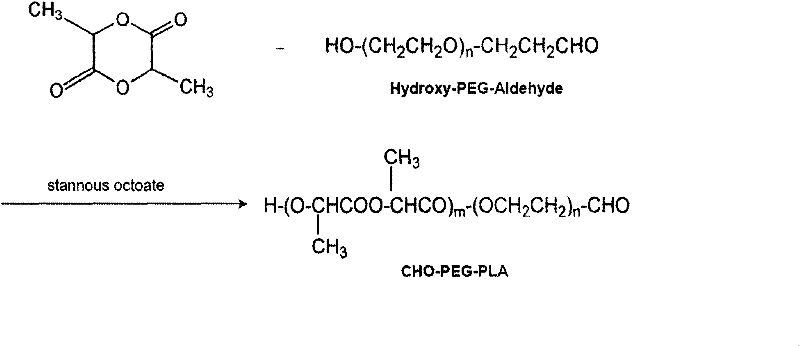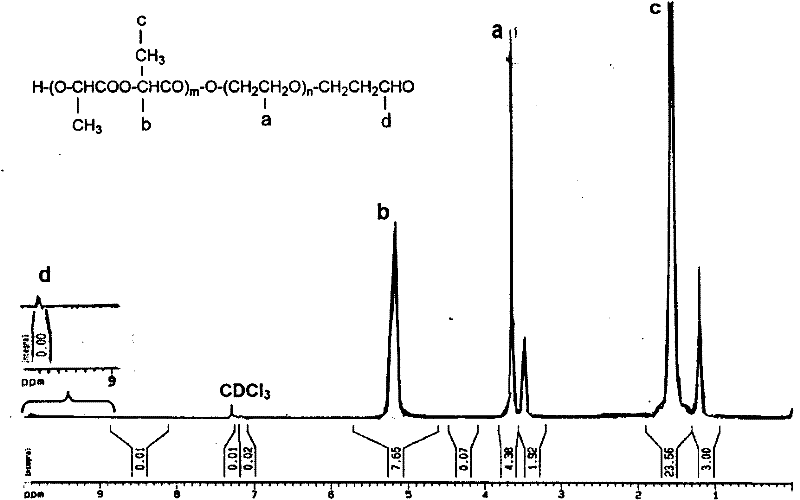A peptide-modified stealth nanoparticle loaded with anti-tumor angiogenesis drug and its application
A technology of polypeptide modification and angiogenesis, which is applied in the field of polypeptide-modified stealth nanoparticles and its preparation, can solve the problems of destroying tumor blood vessels to resist tumors, drug-resistant tumors with limited efficacy, and toxic and side effects, so as to overcome side effects and avoid drug resistance The effect of producing and inhibiting metastasis and recurrence
- Summary
- Abstract
- Description
- Claims
- Application Information
AI Technical Summary
Problems solved by technology
Method used
Image
Examples
Embodiment 1
[0038] Synthesis method and identification of aldehyde-PEG-PLA
[0039] 1. Synthesis method of aldehyde-PEG-PLA
[0040] Hydroxy-PEG-Aldehyde and lactide were placed in a dry flask, dissolved in toluene, catalyzed by stannous octoate, stirred at 70°C for 1.5h under vacuum, and reacted at 140°C for 6h. Cool to room temperature, add CH 2 Cl 2 Dissolve, precipitate with ether, and dry under vacuum at 30°C. For the synthetic route of aldehyde-PEG-PLA see figure 1 .
[0041] 2. Identification of aldehyde-PEG-PLA
[0042] Using IR, 1 H-NMR, 13 C-NMR, GPC (gel permeation chromatography) techniques to confirm the structure, see figure 2 and image 3 . figure 2 Medium, 1643.67cm -1 The characteristic absorption peak of the terminal aldehyde group (HCO) of aldehyde-PEG-PLA polymer can be seen at (shown by the arrow), 1757.87cm -1 The strong absorption peak of the ester bond carbonyl group (C=O) in the polymer can be seen everywhere, and the terminal HCO peak intensity is r...
Embodiment 2
[0054] Preparation of stealth nanoparticles modified by K237 polypeptide loaded with paclitaxel
[0055] 1. Preparation of paclitaxel-loaded stealth nanoparticles by emulsification solvent evaporation method
[0056] Dissolve 1.5 mg paclitaxel in 1 ml containing 30 mg aldehyde-based polyethylene glycol polylactic acid and methoxy-terminated polyethylene glycol polylactic acid in a certain ratio (the ratio is 500:1, it should be noted that the ratio can be 1000:1 -1:1000) mixture in dichloromethane solution, slowly add 3ml 1% (w / v) sodium cholate solution, after 160w ultrasound for 25s, add 40ml 0.5% sodium cholate aqueous solution, gently stir overnight at room temperature, evaporate Organic solvents. The obtained nanoparticle solution was centrifuged at 11,000×g for 45 min, and washed twice with distilled water to obtain paclitaxel-loaded stealth nanoparticles (abbreviated as PTX-NP). For the preparation process of PTX-NP, see Figure 4 .
[0057] 2. Modification of K237 ...
Embodiment 3
[0060] Determination of physical and chemical parameters of nanoparticles
[0061] The particle size and Zeta potential were measured by dynamic light scattering, and the surface morphology was observed by atomic force microscope. The physical and chemical parameters of nanoparticles are shown in Table 1.
[0062] Table-1 Physicochemical parameters of nanoparticles
[0063]
[0064] a The particle size was determined by dynamic light scattering method, and PI is the polydispersity index; b Particle Size Determination by Atomic Force Microscopy
PUM
 Login to View More
Login to View More Abstract
Description
Claims
Application Information
 Login to View More
Login to View More - R&D
- Intellectual Property
- Life Sciences
- Materials
- Tech Scout
- Unparalleled Data Quality
- Higher Quality Content
- 60% Fewer Hallucinations
Browse by: Latest US Patents, China's latest patents, Technical Efficacy Thesaurus, Application Domain, Technology Topic, Popular Technical Reports.
© 2025 PatSnap. All rights reserved.Legal|Privacy policy|Modern Slavery Act Transparency Statement|Sitemap|About US| Contact US: help@patsnap.com



